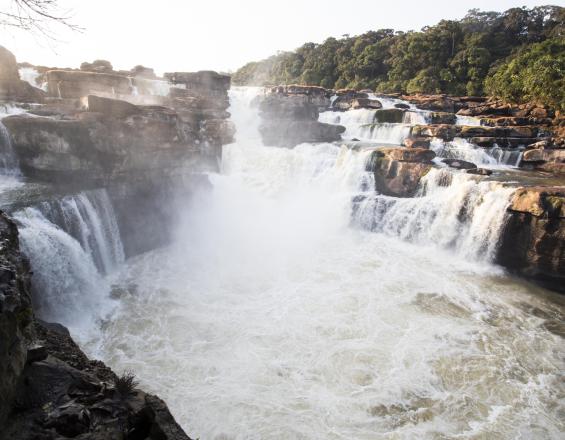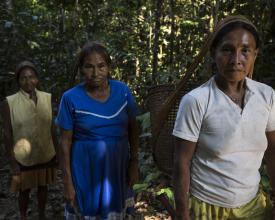
Création et planification de la réserve indigène et du parc national naturel Yaigojé Apaporis à partir d'une cosmovision indigène

Sept peuples indigènes composent la réserve indigène Yaigojé Apaporis dans une zone de grande diversité culturelle de l'Amazonie colombienne. Les activités minières mettant en péril l'ensemble des sites sacrés, les autorités traditionnelles indigènes ont demandé aux parcs naturels nationaux colombiens (PNNC) de créer une zone protégée chevauchant la réserve. Dans ce contexte, la Fondation GAIA Amazonas a mis au point une méthodologie permettant aux communautés indigènes elles-mêmes de gérer la création, la planification et le zonage de la réserve indigène et du parc naturel national Yaigojé Apaporis.
Contexte
Défis à relever
Les sept peuples indigènes qui composent la région de Yaigojé Apaporis forment un groupe culturel unifié qui partage divers éléments, tels que les rituels traditionnels exécutés dans un ensemble de sites sacrés. Cependant, la pression externe des opérations minières sur leur territoire indigène menace leurs sites sacrés, leur environnement naturel et leur culture. Constatant leurs limites face à ces menaces, les communautés ont reconnu la nécessité de demander le soutien du PNNC pour protéger leur territoire par la création d'une zone nationale protégée, qui est un cadre juridique garantissant l'exclusion des activités de développement sectoriel, dans leur cas particulier : les opérations minières. Cette initiative a présenté plusieurs défis. Parmi ceux-ci, la préservation des valeurs culturelles et de la cosmovision indigène, la promotion de l'utilisation des connaissances chamaniques traditionnelles de leurs communautés dans les processus de planification et de zonage, et la mise en place de mécanismes de participation et de dialogue local.
Emplacement
Traiter
Résumé du processus
La création de la zone protégée à la demande des indigènes et avec le soutien du gouvernement national a été réalisée dans le cadre d'un processus de consultation préalable, libre et informée, et de l'établissement d'accords de gestion spéciaux entre le gouvernement et les autorités indigènes, pour la gouvernance de la zone. Deux facteurs clés garantissent que le processus de planification est fondé sur la cosmovision indigène. Tout d'abord, l'existence du régime spécial de gestion (REM), un cadre juridique qui maintient l'inaliénabilité des territoires indigènes lorsqu'ils sont classés en tant que parc naturel national. Deuxièmement, la reconnaissance formelle de leurs valeurs culturelles dans les objectifs de création du parc. À cette fin, la Fondation GAIA Amazonas a dirigé le développement d'une méthodologie appropriée et adéquate qui est devenue un apport fondamental pour les organisations indigènes (en tant qu'autorités publiques) avec le PNNC (en tant qu'autorité environnementale) pour établir les lignes directrices et construire le REM en fonction des caractéristiques culturelles et environnementales de la réserve Yaigojé Apaporis.
Blocs de construction
Soutien de l'organisation sociale locale et du gouvernement national à la création de la zone protégée
La réserve indigène Yaigojé Apaporis a été créée en 1998 à la demande des peuples indigènes Tanimuca, Yucana, Letuama, Matapí, Cabayari, Macuna, Barazano et Yujup-Macú. En 2008, lors d'une session extraordinaire des autorités traditionnelles et des capitaines indigènes (ATCI), ces communautés ont décidé par consensus de demander la création d'un parc national chevauchant les limites de la réserve. Cette demande se fonde sur le fait que cela permettrait d'éviter le développement d'opérations minières et d'autres exploitations de ressources naturelles susceptibles de mettre en péril la biodiversité, leurs sites sacrés et, par conséquent, leurs coutumes, leur composition sociale et leur contexte environnemental.
La création de la réserve indigène et du parc national naturel Yaigojé Apaporis est le fruit d'un long processus de collaboration avec la fondation GAIA Amazonas, qui a bénéficié du soutien technique et financier de la fondation Gordon & Betty Moore. La décision de passer à un régime de gestion spécial (REM) devait bénéficier d'un soutien local total, garantir l'autonomie des communautés indigènes et renforcer leurs systèmes traditionnels. En outre, il était nécessaire qu'elles aient des compétences en matière de négociation et de coordination pour établir un accord avec l'État.
Facteurs favorables
- Les communautés indigènes traditionnelles sont habilitées à prendre des décisions.
- Le cadre juridique colombien reconnaît l'autonomie des autochtones et leur rôle en tant qu'autorités publiques et environnementales sur leurs territoires.
- Disponibilité de ressources financières de la part de l'État et d'organisations étrangères pour mettre en œuvre un processus efficace de consultation préalable informée.
- L'expérience de relations fructueuses entre la PNNC, les autorités autochtones et la société civile pour renforcer la gouvernance environnementale territoriale.
Leçon apprise
Une fois la décision de créer le parc prise, l'étape suivante a été l'accord entre les parcs nationaux naturels colombiens (PNNC) et l'association des capitaines indigènes Yaigojé Apaporis (ACIYA) pour mener à bien un processus de consultation libre, informé et préalable qui permettrait une plus grande participation sociale et une construction collective en termes de définition des limites, d'extension de la zone, d'objectifs de conservation et de construction conjointe du REM. En conséquence, l'ATCI a établi des accords de gestion entre l'État et les autorités indigènes stipulant que la gestion intégrée de la zone serait basée sur les connaissances traditionnelles et les réglementations reçues conformément à la façon de concevoir le monde de chacun des sept peuples indigènes et de leurs 19 communautés, en respectant l'autonomie indigène, leurs droits sur leurs terres communales, leurs sites sacrés et leurs valeurs culturelles. Ainsi, en octobre 2009, la constitution du parc naturel Yaigojé Apaporis a été déclarée.
Planifier la gestion de la réserve indigène et du parc national naturel Yaigojé Apaporis à partir d'une cosmovision indigène
La création de la réserve indigène et du parc national naturel Yaigojé Apaporis a marqué le début d'un nouveau modèle de relation entre les peuples indigènes et le gouvernement colombien. Il était nécessaire de trouver des mécanismes pour assurer la gouvernance et la conservation intégrale de leurs systèmes de vie, sans interférer avec leurs droits à l'autonomie territoriale et à la gestion culturelle qu'ils réalisent traditionnellement. Une fois le parc créé, le processus de formulation de son régime spécial de gestion (REM) a été lancé. Ce régime était l'instrument par lequel l'administration conjointe du parc était partagée entre les parcs nationaux naturels colombiens (PNNC) et l'association des capitaines indigènes Yaigojé Apaporis (ACIYA). L'établissement du REM a nécessité une méthodologie de recherche interne (ou endogène), proposée par les communautés indigènes et soutenue par l'expérience de la Fondation GAIA Amazonas. Cette méthodologie était basée sur les lignes directrices émises par un congrès indigène amazonien qui a identifié les sujets à collecter dans chacune des communautés, afin d'orienter la conception du MER. Cette approche a permis de promouvoir la participation des communautés indigènes, composées de trois représentants et d'un chaman.
Facteurs favorables
- La figure juridique du REM qui maintient l'inaliénabilité des territoires indigènes lorsqu'ils acquièrent une catégorie de parc national.
- Développement d'une méthodologie interne, dirigée par la Fondation GAIA Amazonas en collaboration avec les organisations indigènes, pour établir les lignes directrices de l'OI en fonction des particularités du parc et du régime de gestion.
- Disponibilité financière des ressources de l'État et soutien externe pour mettre en œuvre un processus participatif de construction de l'OI.
Leçon apprise
Le processus de recherche pour développer le MER a été réalisé en deux ans. L'accord de coopération 011 de 2013 conclu entre le PNNC et ACIYA a fixé un délai raisonnable de cinq ans pour la construction, la formalisation et la mise en œuvre conjointe du MER. Ce processus a permis de
- Sauvegarder les valeurs ancestrales.
- Promouvoir une plus grande implication des jeunes dans la conception de l'OI.
- Revaloriser les connaissances traditionnelles.
- Générer une plus grande relation de coordination et de gestion de la zone entre le personnel du PPNC et les populations indigènes.
- Générer une meilleure compréhension des caractéristiques biologiques du territoire et de sa valeur culturelle, afin de contribuer à la conception des stratégies de gestion du parc.
- Devenir un modèle reproductible pour d'autres REM en Amazonie colombienne, puisqu'il permet d'intégrer les connaissances traditionnelles sur l'utilisation des ressources naturelles aux politiques du PNNA en matière de gestion des zones protégées.
Impacts
- Le processus de création de l'aire protégée et de conception de son régime spécial de gestion (RSG) s'est appuyé sur les principes de la participation sociale et de la construction collective entre le PNNC, les autorités indigènes et les capitaines de la réserve Yaigojé Apaporis.
- La fonction publique de conservation et de gestion de l'environnement dans la zone a été coordonnée sur la base des systèmes culturels de régulation et de gestion du territoire des peuples indigènes.
- Grâce à un processus de consultation préalable, libre et informée, des accords ont été conclus entre le gouvernement et les autorités indigènes afin que la gestion de la zone soit basée sur les connaissances traditionnelles et respecte leur autonomie et leurs droits sur leurs terres communales, leurs sites sacrés et leurs valeurs culturelles.
- Grâce à la création du parc national, l'association des capitaines indigènes Yaigojé Apaporis (ACIYA) a protégé plus d'un million d'hectares de forêt tropicale humide et a convenu avec le gouvernement d'un modèle de gestion de l'environnement fondé sur ses connaissances traditionnelles.
- L'application d'une méthodologie de recherche endogène dans la conception du REM a permis de sauver les valeurs ancestrales, de stimuler la participation des jeunes, de renforcer les liens entre le personnel du PNNC et les populations indigènes, et de comprendre les valeurs biologiques et culturelles de la zone afin de générer des stratégies de gestion.
Bénéficiaires
Les sept principaux peuples indigènes de la région appartiennent aux groupes Macuna, Tanimuka, Letuama, Cabiyarí, Yauna, Barazano et Yujup Macú, et comptent une population approximative de 1 536 personnes réparties dans 19 communautés.
Objectifs de développement durable
Histoire

"GAIA travaille avec les populations indigènes d'Amazonie depuis 25 à 30 ans, et notamment avec les habitants de la réserve indigène d'Apaporis. Notre premier pari, dans les années 1980, a été d'obtenir la reconnaissance juridique de la réserve indigène. Ensuite, nous nous sommes attachés à renforcer les systèmes organisationnels et gouvernementaux, ce qui a permis de décentraliser la fourniture de services de base tels que l'éducation et les soins de santé, toujours dans une perspective culturelle, environnementale et territoriale.
Lorsque la menace minière a été identifiée en 2007-2008, pour les demandes de titres miniers par une entreprise canadienne, nous avons commencé à travailler avec la population indigène pour créer des stratégies conjointes pour la conservation de leur territoire. Il est apparu que la création d'un parc naturel permettrait non seulement de protéger son territoire et son sous-sol, mais qu'un exercice de coordination avec les parcs nationaux naturels colombiens renforcerait les systèmes de gestion existants de ces territoires. Ce dernier objectif a été atteint grâce à la reconnaissance des populations indigènes en tant qu'autorité environnementale. Mais en plus du travail sur la protection juridique du territoire, nous avons également renforcé les processus de recherche locale ou endogène. Cela montre clairement une articulation entre les jeunes leaders et les connaissances traditionnelles des peuples indigènes qui habitent ce territoire.
Il est important de souligner qu'il ne s'agit pas seulement d'un pari sur la création d'un parc national, mais aussi dans le contexte d'un macro-territoire bio-culturel où nous avons trouvé des complémentarités avec d'autres organisations et communautés indigènes avec lesquelles nous avons travaillé dans la gestion intégrale de leur territoire. C'est pourquoi nous avons cherché à trouver des complémentarités d'un point de vue environnemental, écosystémique et culturel dans les territoires où nous travaillons.
Enfin, il est important de souligner que notre travail se traduit par un exercice réussi de relation et de coordination entre les peuples indigènes reconnus comme autorité environnementale, les parcs nationaux de Colombie et l'accompagnement d'une ONG qui a persisté et a été constante au fil des ans, et a construit une forte confiance avec les peuples indigènes et avec les autorités gouvernementales. Cela nous a permis d'atteindre un niveau d'articulation et de complémentarité avec le point de vue culturel du territoire, afin qu'il atterrisse dans des instruments de planification et de gestion adaptés à la culture occidentale, en fournissant un accompagnement harmonieux et constructif".


















